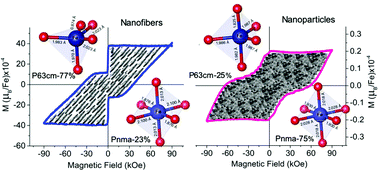Unusual magnetic ordering transitions in nanoscale biphasic LuFeO3: the role of the ortho–hexa phase ratio and the local structure†
Abstract
Understanding nanoscale ferromagnetism is becoming increasingly important in view of our enhanced ability to control growth and morphological features of complex nano-systems and their potential translation into emergent high density magnetic device technologies. In this work, we have examined the combined consequences of the magneto-crystalline anisotropy, shape anisotropy, intrinsic phase coexistence, and surface induced self-strain and related anisotropy on the magnetism and magnetic transitions in the case of nanoparticles (NPs) and nanofibers (NFs) of the intriguing multiferroic LuFeO3. We find that the two systems exhibit remarkable differences in the magnetic transitions as well as the value of the canted antiferromagnetic moment by virtue of significant differences in the relative hexagonal (h) and orthorhombic (o) phase contents with the h : o phase contribution in NPs (NFs) being 25 : 75 (77 : 23). In the case of NFs with a major hexagonal component, the bifurcation of ZFC and FC magnetization curves is seen to occur above room temperature with a transition seen at about 150 K, a feature reflecting in-plane (a and b) antiferromagnetic order. In the case of NPs with a dominant o-phase, a weak ferromagnetic (canted antiferromagnetic) signal is noted from 300 K (maximum measurement temperature) down to about 274 K, at which point the antiferromagnetic susceptibility feature is seen. Below 223 K a reentrant ferromagnetic order is seen down to 153 K, at which point a bifurcation is noted between FC and ZFC curves. After subtracting the major component of the field dependent linear moment, the weak ferromagnetic (canted) moment at 300 K is almost 2 orders higher in the case of NFs than NPs. A detailed analysis of phase constitution, local structure and lattice-distortions is performed using X-ray diffraction, Raman spectroscopy, and synchrotron-based X-ray absorption near edge structure (XANES) spectroscopy. The potential significance of the interfaces in influencing the canting via gradient spin order distribution is emphasized.



 Please wait while we load your content...
Please wait while we load your content...
